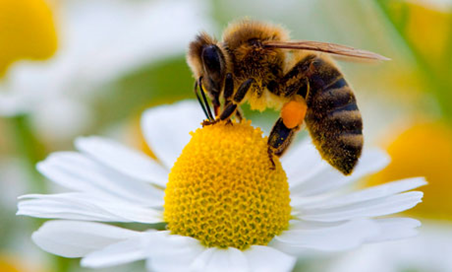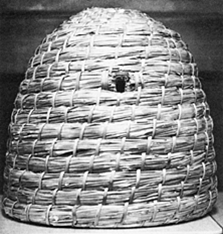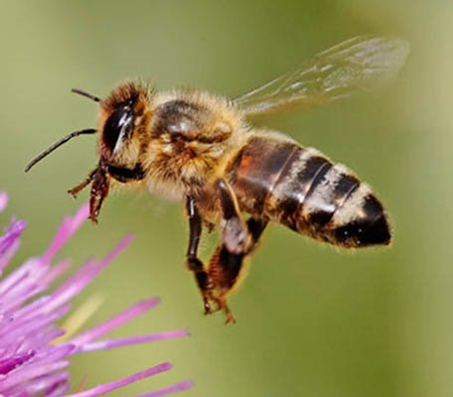Bees at work at Rippon Lodge
 We Must Protect This Critical Player in the Production of Food, Trees and Flowers
We Must Protect This Critical Player in the Production of Food, Trees and Flowers
Bees provide a critical service by pollinating plants so they can produce food and flowers. Without bees, our crops would fail. Simply put, we need bees.
Bees are now facing a serious threat to their survival. Honey bees are decreasing in numbers because of Colony Collapsed Disorder (CCD), pesticides, viruses, and flowerless landscapes. Honey bees are also very important to the environment because they pollinate 2/3 of the world's plants. Many people don't understand how important honey bees are to our lives.
To help preserve and restore honey bees, Rippon Lodge is hosting local honey bee hives.
Providing A Sanctuary for Bees: A unified effort between local government and local beekeepers
 The original hives were placed at Rippon Lodge Historic Site as a Gold Award project by a local Senior Girl Scout, who trained to be a beekeeper. Learning from a local expert, (Bees in School, LLC.), who provided ongoing support and assistance with issues at the hive, this Girl Scout successfully raised the bees and within two years harvested honey, which we sold in our gift shop. In addition, the beekeeping club of Freedom High School participated in the project.
The original hives were placed at Rippon Lodge Historic Site as a Gold Award project by a local Senior Girl Scout, who trained to be a beekeeper. Learning from a local expert, (Bees in School, LLC.), who provided ongoing support and assistance with issues at the hive, this Girl Scout successfully raised the bees and within two years harvested honey, which we sold in our gift shop. In addition, the beekeeping club of Freedom High School participated in the project.
Since then, Rippon Lodge Historic Site continues to support honeybees as well as other pollinators. There are two healthy, active hives on the grounds. Our site offers a yearly educational program about bees and their important role in our food supply. When possible, the honey harvested is sold in our gift shop.
Bees are not new to Rippon Lodge Historic Site. Many wild bees already visit the floral and vegetable gardens almost daily from spring to fall.
For Your Safety
- We have established a safety perimeter around the hives. Please do not approach the hives for your safety and the bee's safety.
- Please do not swat, taunt or aggravate the bees on the property.
- The hive is in an open field. It is not part of the travel area for visitors or an interpretive area.
- When bees swarm, it is not an aggressive attack. It is the first Queen Bee leading part of the bees from the hive to seek a new location for a new hive. This occurs when the bees outgrow the first hive and a new Queen Bee is ready to take over.
- If you are stung, please seek a member of the Rippon Lodge staff to assist you. If more advanced medical help is required or upon your request, staff will contact the nearby Fire and Rescue station. Please be sure to carry your prescribed medicines on the property if you have an allergy to bee stings.
History of Beekeeping in the U.S.
 The honey bee (Apis mellifera L.) is not native to the Western Hemisphere. Information available indicates that colonies of honeybees were shipped from England and landed in the Colony of Virginia early in 1622.
The honey bee (Apis mellifera L.) is not native to the Western Hemisphere. Information available indicates that colonies of honeybees were shipped from England and landed in the Colony of Virginia early in 1622.
One or more shipments were made to Massachusetts between 1630 and 1633, others probably between 1633 and 1638. According to the USDA, it is reasonable to assume that bees were brought by the colonists to New York, Pennsylvania, Carolina, and Georgia.
Records indicate that honey bees were present in the following places on the dates shown: Connecticut, 1644; New York (Long Island), 1670; Pennsylvania, 1698; North Carolina, 1730; Georgia, 1743; Alabama (Mobile), 1773; Mississippi (Natchez), 1770; Kentucky, 1780; Ohio, 1788; and Illinois, 1820 (Oertel 1976).
By 1800, honeybees were widely distributed from the Atlantic Ocean to the Mississippi River.
To ensure the future of bees, it is important that we all strive to create a safe and protected area for bees to maintain their hives.
Fun Facts about Honeybees
- The honeybee has been around for millions of years.

- It is the only insect that produces food eaten by man. Honey is the only food that includes all the substances necessary to sustain life, including enzymes, vitamins, minerals, and water. It also helps to improve brain function.
- Their sense of smell is so precise that it could differentiate hundreds of different floral varieties and tell whether a flower carried pollen or nectar from miles away.
- The honeybee's wings stroke incredibly fast, about 200 beats per second, thus making their famous, distinctive buzz. A honeybee can fly for up to six miles, and as fast as 15 miles per hour.
- A honeybee visits 50 to 100 flowers during a collection trip. The average worker bee produces about 1/12th teaspoon of honey in her lifetime.
- The bee's brain is able to make complex calculations on distance travelled and foraging efficiency.
- A colony of bees consists of 20,000-60,000 honeybees and one queen. Worker honeybees are female, live for about 6 weeks and do all the work.
- Honeybees communicate with one another by dancing.
- During winter, honeybees feed on the honey they collected during the warmer months. They form a tight cluster in their hive to keep the queen and themselves warm.
Contact Us
For more information or to report concerns, please contact the Office of Historic Preservation at 703-792-4754 or email [email protected].